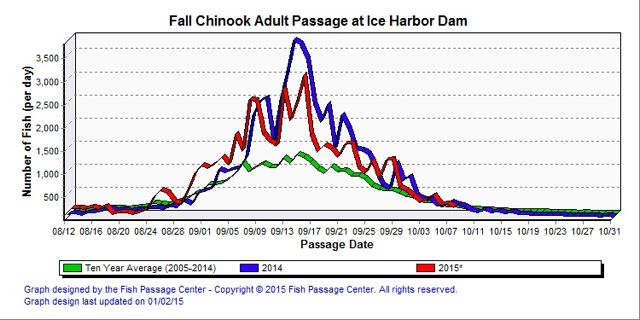forum
library
tutorial
contact

Field Reports: 2015
Whopper Year for Fall Chinook
by Staff and Wire Reports
Spokesman-Review, November 15, 2015
|
the film forum library tutorial contact |

|
Field Reports: 2015
by Staff and Wire Reports
|
It's a 77-year record, actually

 FISHING -- Another season of record-setting fall chinook runs has been recorded on the Columbia and Snake rivers, but they're also delivering signals that the bounty will decline in coming years.
FISHING -- Another season of record-setting fall chinook runs has been recorded on the Columbia and Snake rivers, but they're also delivering signals that the bounty will decline in coming years.
Fall chinook set return records for the Columbia River above Bonneville Dam, in the Hanford Reach near the Tri-Cities as well upstream into the Snake River.
Through Tuesday, 953,240 fall chinook had been counted at Bonneville Dam topping the record of 953,222 set in 2013.
A record 200,000 of those chinook, known as upriver brights, are spawning in the Hanford Reach, a freeflowing section of the Columbia near the Tri-Cities.
A record harvest of 35,430 fall chinook was recored in the reach before the season closed Oct. 31, toppint the 2014 total of 32,430, according to Washington Department of Fish and Wildlife statistics.
Anglers turned out big for the big run, with 48,000 angler trips in the Hanford Reach alone observed by department counters in 2015, up from 44,098 in 2014.
The most dramatic increases in fall chinook are in the Snake River.
Only 78 fall chinook returned to the Snake River above Lower Granite Dam. Through Wednesday, 59,027 adult fall chinook had been counted passing the dam (35 miles west of Clarkston), just short of the 60,161 counted last year, the record high since the dam was completed in the 1970s.
Snake fall chinook records have set high marks in 2010, 2013 and 2014.
Columbia system record runs owe to a number of factors from the ocean to river flows and habitat improvements. But in the Snake, the increases are largely due to Nez Perce Tribal fisheries efforts, including hatchery development.
The majority of the Snake chinook returning this year and in recent years are from hatcheries, but 30-50 percent are natural origin fish hatched in the gravel of the Clearwater, Snake, Grande Ronde and Imnaha rivers.
Natural origin fall chinook in the Snake River are protected as a threatened species under the Endangered Species Act.
On a sour note, only 11,448 fall chinook jacks -- fish that return after just one year in the ocean instead of two or more -- were counted passing the Lower Granite Dam this fall. That is the lowest number since 2008 and could be another signal that ocean conditions are turning poor.
This year's coho run is likely an early sign of the less productive conditions in the ocean. Only 1,309 coho were counted at Lower Granite Dam, compared with a high of nearly 18,000 last year. In the Columbia River, coho numbers dipped from a massive 275,560 counted last year at Bonneville Dam to only 35,661 this year.
learn more on topics covered in the film
see the video
read the script
learn the songs
discussion forum
